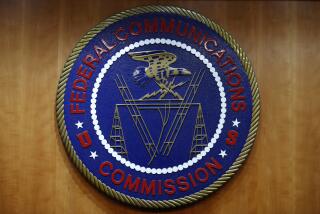FCC Sets Auction for New Broadcast, Paging Licenses : Technology: Summer bidding may transform how Americans communicate, watch TV.
- Share via
WASHINGTON — Clearing the way for the first government auctions of licenses for advanced new telecommunications services, the Federal Communications Commission on Wednesday gave final approval to new broadcast and paging technologies that promise to transform the way many Americans communicate and watch television.
The FCC voted unanimously to auction 10 nationwide and 3,543 local and regional licenses for so-called narrow-band personal communications service, a wireless technology that offers two-way paging and data transmission.
The FCC also approved auctions for about 1,450 licenses for interactive video and data service, or IVDS, that will allow viewers to respond to broadcast and cable programming. The auctions will take place this summer, the FCC said.
Both technologies are forerunners of more advanced offerings expected next year: broad-band PCS, a cellular phone competitor that will offer two-way voice and data services through wireless transceivers that will eventually be as portable and unobtrusive as a wristwatch, and multipoint distribution service, a cellular-style video service that can provide interactive TV, data transmission and telephone service.
With Wednesday’s vote, FCC Chairman Reed Hundt said the agency “is jump starting a competitive industry in interactivity and mobile telephony.” By having auctions, Hundt added, “we will attract people who want the business and make sure consumers have . . . a real choice.”
The FCC’s green light is significant because narrow-band PCS and IVDS would be the first FCC licenses to be auctioned to private companies under a Clinton Administration plan that is expected to raise $7 billion to $10 billion over the next four years.
Narrow-band PCS will improve on today’s pagers by being smaller and more powerful and by allowing the devices to acknowledge electronically that a message has been received. PCS pagers will also be able to send and receive data.
TV, too, will gain flexibility with IVDS which uses radio waves and satellites to provide an electronic return path that viewers can use to respond to what they watch on television. The system, which will connect to TVs through a set-top box and display on-screen icons to prompt viewers, is a rudimentary but low cost way to provide interactive communications.
“We can make a wireless drop into a household for $1.35, and neither PCS or cable is that cheap to install; that makes us an attractive partner” for those seeking to provide interactive services, said R. Michael Sheridan, president of EON Corp., a leading Reston, Va.-based interactive TV company.
EON will likely be among hundreds of others--ranging from computer giant IBM to the NBC television network--that have expressed interest in offering PCS or interactive TV services. For months, say experts, scores of the hopeful have been conducting mock competitions to hone their bidding skills for the auctions.
Despite the anticipation over auctions, there has been some grumbling about the timing, with some complaining that PCS has been delayed so long that cellular phones, which have begun bundling pagers into one device, have overcome their technological shortcomings.






